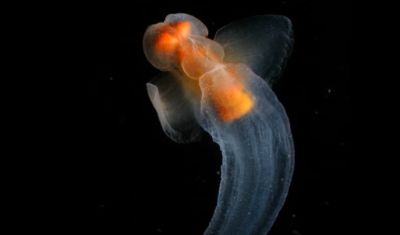Home › Sea Life › Marine › Invertebrates › Mollusks › Nudibranchia › Sea Angels
Fun and Interesting Facts about Sea Angels
[Sea Angel Phylum: Mollusca] [Class: Gastropoda] [Order: Pteropoda] [Suborder: Gymnosomata]
They are often mistaken for sea snails, especially sea butterflies, but sea angels are tiny free-swimming gelatinous sea slugs that spend their whole lives swimming at sea.
Check out these lesser-known sea angel facts and find out how members of the clade Gymnosomata fulfill such an important component in marine food webs.
Sea Angels Habitat and Geographical Range
Some sea angel species can be found occupying almost all deep water pelagic zones around the world.
So, where do sea angels live in the ocean? In fact, being a pelagic sea slug means they inhabit the open ocean and drift with currents.
In general, they live away from the shorelines of most warm and cold seawater environments, from polar regions to the tropical seas.
For example:
Clione limacina are commonly found in the ice cold waters of the Arctic Ocean and North Atlantic, and even as far south as the Sargasso Sea.
Unlike most nudibranchia and sea slugs, members of the clade Gymnosomata do not live and crawl around on the seabed. Instead, they swim in the upper to mid-water column. They exist near the surface and even at depths of 1,600 metres (more than one mile below sea level).
Sea Angel Characteristics and Behaviour
One of the key features of their close relatives, the sea butterflies, is the calcified shell. However, sea angels lose their shell as they develop, leaving behind a translucent body (almost completely transparent) and a clear view of their internal structures.
Once the external shell has gone, soon after the larval stage, they are able to swim by flapping their parapodia in a slow, deliberate, and somewhat graceful and rhythmical hovering motion.
The wing-like flapping appendages (called parapodia) mean they can swim freely in the water column. So, they're not confined to life near reef formations or other structures on the bottom of the ocean.
Their body is streamlined and elongated, and fully grown adults rarely grow much bigger than a few centimetres long.
 Even so, some of the polar species have been documented at seven (7) centimetres in overall length.
Even so, some of the polar species have been documented at seven (7) centimetres in overall length.
Here's the thing:
At five (5) centimetres long (2 inches), Clione limacina is one of the biggest in the sea angel species (Gymnosomata).
In comparison, Paedoclione doliiformis is one of the smallest, measuring less than five (5) millimetres in length.
What Do Sea Angels Eat?
Gymnosomata sea angels are specialised predators that mostly focus on eating sea butterflies (Thecosomata) for the soft body tissues.
Sea angels use grasping hooks located near the mouth and their retractile tentacle-like oral structures to capture them.
They are particularly fond of targeting the Limacina species, a genus of pelagic swimming sea snails, and several other pteropods.
The species of sea angels that are unable to digest the shell will discard it after feeding. Others are opportunistic feeders that will consume tiny zooplankton and larval mollusks.
Types of Sea Angel Species
Antarctic Sea Angel (Clione antarctica)
Canephora Sea Angel (Pneumodermopsis canephora)
Common Sea Angel (Clione limacina)
Diaphanous Sea Angel (Thliptodon diaphanus)
Doliiform Sea Angel (Paedoclione doliiformis)
Krohn's Sea Angel (Cliopsis krohni)
Mediterranean Sea Angel (Pneumoderma mediterraneum)
Okhotsk Sea Angel (Clione okhotensis)
Pacific Sea Angel (Clione elegantissima)
Punctate Sea Angel (Fowlerina punctata)
How Do Sea Angels Reproduce?
There are more than three thousand species of sea angels and all of them are simultaneous hermaphrodites, thus they need a partner to reproduce.
Individuals possess male and female reproductive organs, and they can produce eggs and sperm at the same time, but they are unable to self-fertilise.
Mating and Egg-laying Strategies
The seasonal courtship ritual takes place in open water when two individuals pair up and align their bodies. They may stay together for several hours while they exchange sperm and begin the internal fertilisation process.
Following that, they release a mass of gelatinous strings (egg clusters) into the water column. Their eggs have a tiny coiled, thimble-shaped shell when they first hatch into free-swimming larvae.
Sea angel larvae resemble miniature sea butterflies during the initial stage of their development. But, they lose the shell during metamorphosis and develop their distinctive paired parapodia as they transition into the familiar sea-angel adult form.
Sea Angel Predators and Threats
In the wild, sea angel predation occurs most from pelagic fish, especially cod and salmonids (e.g., chars, salmon, trout, and whitefishes).
Other organisms that eat sea angels in large numbers include:
- Jellyfish and siphonophores (colonial hydrozoans)
- Seabirds (less common)
- Zooplankton (chaetognaths and other predatory planktons)
Moreover, they are not immune to some environmental threats and human-driven behaviours and activities, such as:
- Ocean acidification is considered as being the most significant threat mainly because the aragonite shells of sea butterflies (their main source of prey) dissolve more easily in acidifying waters.
- Warming oceans have a major impact on the kinds of sea angels that are adapted to cold water. It shifts their ranges towards the poles and it can disrupt reproductive timings that are tied to seasonal prey blooms.
- Localised pollution in the ocean, particularly pelagic microplastic density, interferes with the planktonic food webs that sea angels depend on.
Related Information and Help Guides
- Facts about Glaucus Atlanticus Blue Dragon Sea Slug
- Anatomy of a Sea Slug with Labelled Diagram
- Nembrotha Kubaryana: Facts about Dusky Nembrotha
Note: The short video [1:41 minutes] presented by 'Deep Marine Scenes' contains even more sea angel facts with some amazing footage of these tiny free-swimming marine gastropod mollusks.